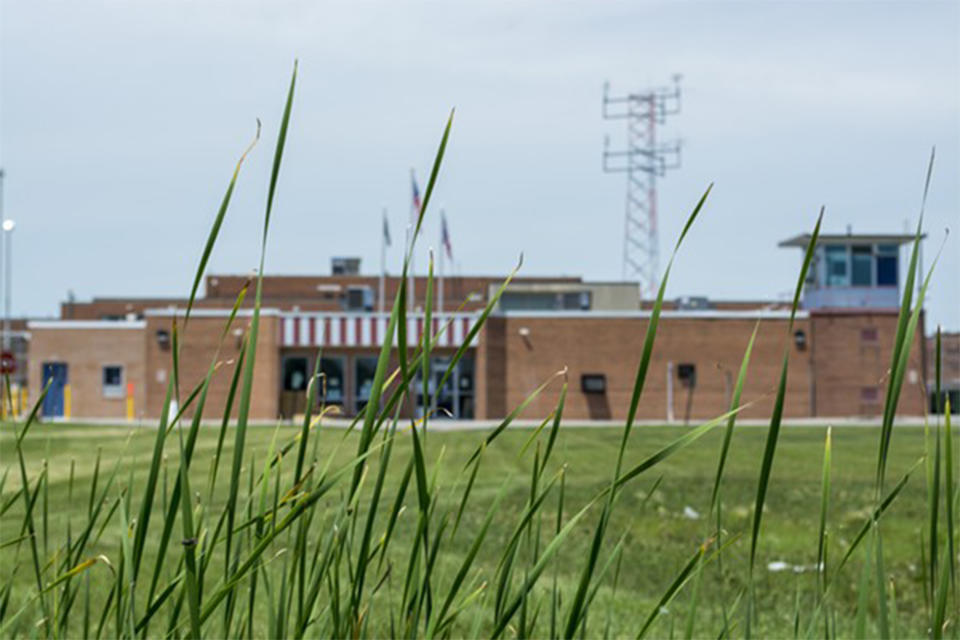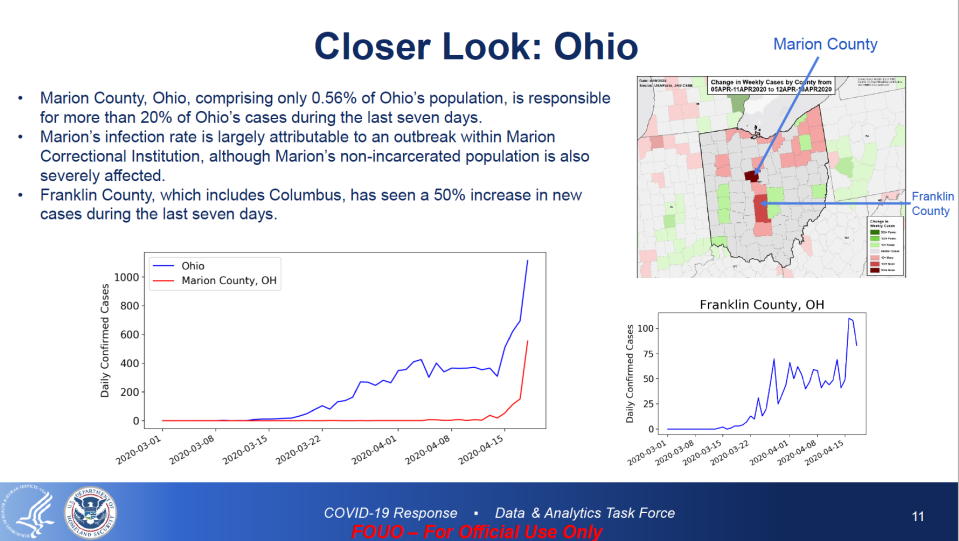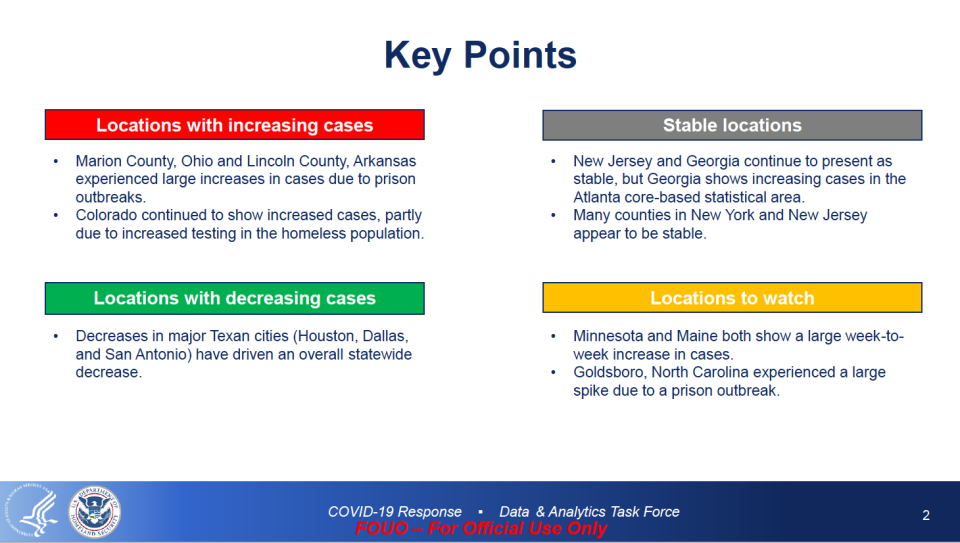'These prisoners are tinderboxes of infection': How a Midwestern county became the center of one of fastest-growing coronavirus outbreaks in the U.S.
For much of the past month, national attention has been focused on large coronavirus-stricken metropolitan areas like New York, but over the past week a small county in Ohio has had such an alarming surge in coronavirus cases that it has drawn the attention of government agencies responsible for containing the outbreak.
Driven by an exploding number of cases among inmates at the Marion Correctional Institution, Marion County, Ohio, which has a population of less than 70,000 according to the last census, has registered a more than 2,500 percent increase in the past seven days. That increase is one of the highest in the country, according to briefing slides obtained by Yahoo News from the Data and Analytics Task Force, which is run jointly by the Department of Health and Human Services and Department of Homeland Security.
Health experts and prisoner advocates have been warning that inmates are vulnerable to outbreaks because of overcrowding and an inability to socially distance. Along with threatening the health of inmates, such outbreaks can easily spread outside the prison, as staff become infected and then infect others in their communities.
“These prisoners are tinderboxes of infection,” said David Singleton, executive director of the Ohio Justice & Policy Center, which provides legal assistance to inmates. “And once it gets in the prison it’s going to take off, and there’s really nothing much you can do if you’re overcrowded.”

The minimum- and medium-security men’s prison in Marion County, with around 2,600 inmates, appears to prove that point. There are currently more than 2,000 cases in Marion Country, according to official statistics, and the vast majority of those are inside the prison. The number of cases outside the prison is also increasing, however.
“Marion’s infection rate is largely attributable to an outbreak within Marion Correctional Institution, although Marion’s non-incarcerated population is also severely affected,” according to the Data and Analytics Task Force.
The data task force, which reports to the White House coronavirus task force, identifies the county as a special concern. It says in its briefing the county contains less than 1 percent of the state’s population but now has more than 20 percent of Ohio’s cases.
Confirmed cases are also spreading at several other prisons in Ohio, including Pickaway Correctional Institution, which now has more than 1,500 cases.
While overcrowding at Ohio’s prisons has been cited as the main factor contributing to the explosive growth in coronavirus cases, a separate DHS report notes that a shortage of personal protective equipment (PPE) has been a “contributing factor” to the outbreak there.
DHS and HHS did not immediately respond to requests for comment. The Ohio Department of Rehabilitation and Corrections also did not respond to a request for comment about the lack of PPE.
There were no reported COVID-19 deaths at the Marion prison as of Tuesday, and only one probable coronavirus-related death in the Ohio prison system as a whole.
The state’s Republican governor, Mike DeWine, has been generally praised for his quick response to the coronavirus, and the rapid uptick in cases at the prisons reflects an increase in testing. But the governor has also come under fire from criminal justice advocates for doing little to ease overcrowding in Ohio’s prisons.

DeWine has recommended the early release of more than 100 inmates, including a victim of sex trafficking convicted of killing her pimp, whose case was championed by reality star Kim Kardashian. But those releases fall far short of what is needed to address overcrowding, according to critics.
“He could have released a lot more people under the authority. There’s a statute that allows for emergency release to reduce overcrowding, and that’s focused primarily on releasing lower-level folks who are within 90 days of their sentence,” Singleton argued.
Claire Chevrier, policy counsel at the American Civil Liberties Union of Ohio, places the blame for the prison outbreak directly on DeWine, saying that the other positive measures he has taken, such as closing schools, are being undermined by his refusal to address the situation in prisons.
“We have maintained for quite some time that the way out of this would have been to ramp up efforts to release as many people as possible who don’t need to be locked up anymore,” she said. “And while I think the governor has done a really good job generally with addressing COVID in the community, he's been very tepid in his response to what’s happening in the prisons.”
While DeWine took a number of key steps early on, Chevrier notes that the ACLU warned him in letters dating back to March 10 that action needed to be taken at the prisons.
“Gov. DeWine has been applauded for his fast action to curb the spread of the coronavirus. He was one of the first governors to shut down schools and restaurants. And we’ve been under a stay-at-home order for weeks and weeks in Ohio,” she said. “Unfortunately, this same quick action was not taken with prisons, and that’s why what is currently happening, it’s devastating, but it was also a policy choice.
“We are 10,000 people over capacity in Ohio prisons, and Gov. DeWine has suggested the release of fewer than 1 percent of the total population,” she said.

The releases the governor has allowed are “a drop in the bucket, and it is not going to save the remaining people who are in prison or the communities who are about see a huge spike in hospital requirements,” said Chevrier.
A spokesperson for DeWine did not respond to a request for comment, but the governor appears to be sticking to his position about early release. In a series of tweets posted April 20 addressing the prison outbreak, DeWine noted that the state was taking action, such as using the National Guard to expand facilities, but would not consider releasing entire categories of inmates.
“We do not intend to do a wholesale release where every one in a certain category gets out of prison,” he wrote. “We need to do this thoughtfully, and we want to protect our corrections employees and inmates.”
Singleton argued that no measure, absent a larger release of inmates, is likely to help contain the outbreak.
“We are blessed in Ohio with a very good director of the whole system, but her hands are tied with the numbers of prisoners that she’s got,” he said. “And there’s only so much she can do in terms of keeping people safe in a population that is overcrowded.”
In the meantime, inmates are facing rampant coronavirus, with no options to socially distance.
“The clients that I am in touch with are scared. They’re anxious,” Singleton added. “Their families are very anxious.”
Jana Winter contributed reporting.
_____
Click here for the latest coronavirus news and updates. According to experts, people over 60 and those who are immunocompromised continue to be the most at risk. If you have questions, please refer to the CDC’s and WHO’s resource guides.
Read more:



